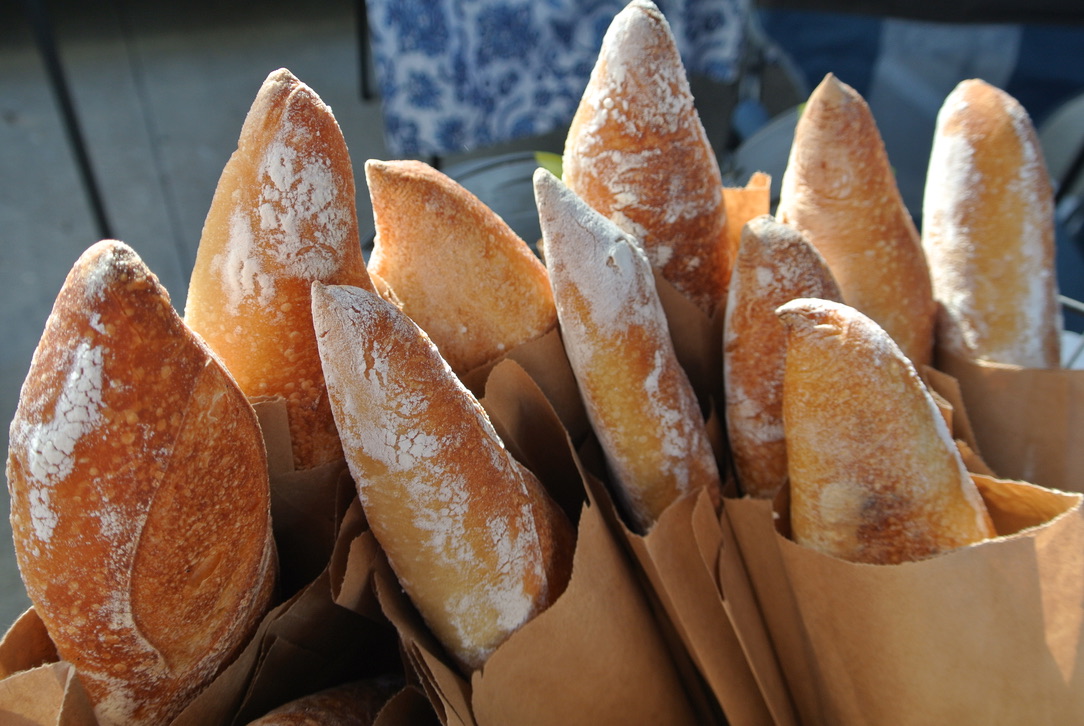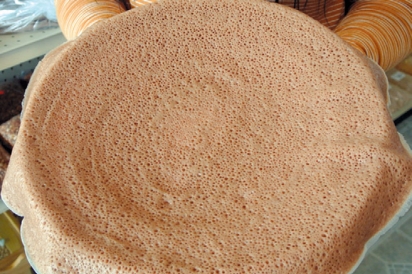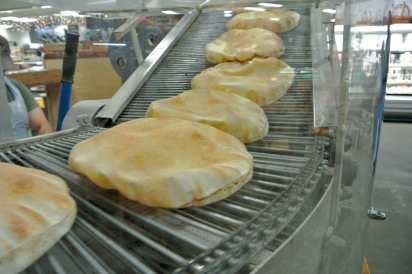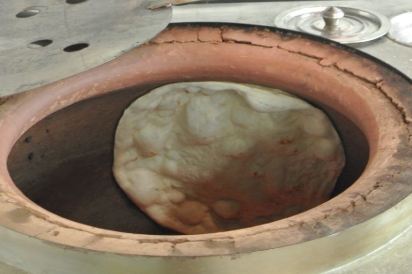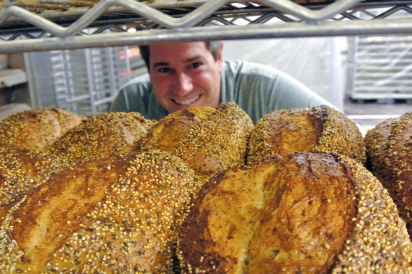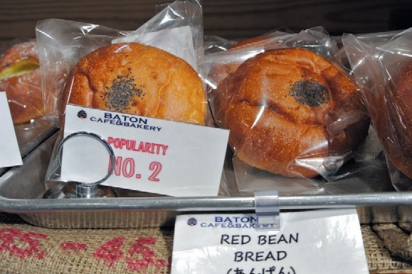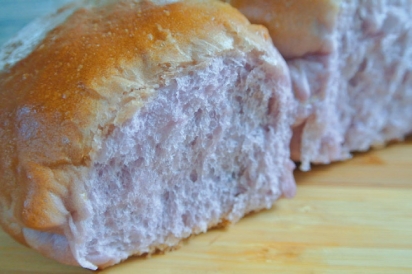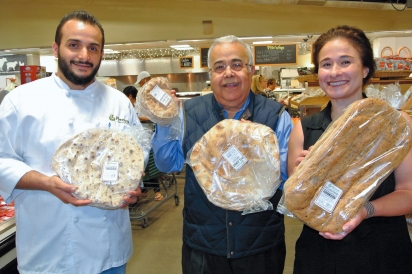France
Baguette
Its name means “stick.” It is the quintessential golden-brown, crusty French loaf about two feet in length. Here the artisan bakers make a sourdough version using organic flour that gives the exterior a rich golden-brown color. It is as crispy as they come with a wonderfully airy crumb.
Bâtard
Its name means “bastard” because it is neither a baguette nor a pain rond (round loaf). It is shorter, wider and flatter than a baguette, just as crispy and with a similar consistency. This version has a deep, dark-brown crust with a very airy crumb.
Pain D’Épi
The only difference between the épi and a baguette is the way the épi is cut to resemble a wheat stalk. The cuts expose even more of the loaf, essentially forming eight oval-shaped rolls, making even more desirable than a baguette from a crispiness standpoint.
Brioche
Rich in butter, plus lots of eggs, this loaf definitely has a rich and soft white crumb. The shiny dark brown exterior is due to an egg wash used just before baking. It is an oblong loaf, about 10 inches long, that has been pre-sectioned into eight pull-apart rolls.
Germany
Central Market, 3815 Westheimer Rd.
Bavarian Rye
This large, dome-shaped loaf with what resembles a starfish design on top is made with wheat and rye flour and a good amount of sourdough starter, giving this dense and heavy loaf a unique sour flavor. The exterior is a dark brown with the interior a lighter brown and the crumb very chewy and firm.
Pretzel
A soft pretzel has a sheen and a similar chew to a bagel, since it too has been dipped in a water bath before baking. In the case of the pretzel, the water is mixed with lye, turning the exterior yellow then a deep, glossy brown when fully baked. Topped with coarse salt, it is shaped into a twisted knot with tapered ends and a thicker midsection—a shape that has represented German bakers’ guilds since the 12th century and, according to legend, resembles a person praying with crossed arms.
Pumpernickel
Made with rye, wheat and barley and hints of caraway, this large, dense, slightly sweet, intensely dark-brown, football-shaped loaf comes from Westphalia in northwestern Germany. It is often used to make open-faced sandwiches. The name originated in the 16thcentury and means “farting boor” from pumpernto pass gas and nickel from Nicholas, a name often associated with boorish figures. It got its name from how hard it was to digest.
Greece
Greek village bread
The recipe for this bread came from Tasos Katsaounis, the bakery owner’s grandmother, so you know it’s been time-tested. This is the first loaf he ever baked commercially and he’s especially proud of it. It is a large oval sourdough loaf with a very crispy crust enhanced by a deep cut made on the top of the bread, exposing as much as possible. The crumb is soft and airy.
Kalamata olive bread
A long, oval shape with a moderately crispy crust, chewy crumb, and lots of briny, coarsely chopped, purple-black Kalamataolives and oregano make this a bread you won’t be able to stop eating.
Guatemala
El Quetzal bakery, 5939 S. Gessner Rd.
Avion
This small roll is shaped like an airplane (avionin Spanish). It is a French-style bread. The locals call it pan desabrido, or tasteless bread.
India
Roti/chapati.
This unleavened thin flatbread is traditionally prepared on a stovetop but at this market they crank up the machine twice a day to make these discs that resemble flour tortillas in size, shape and color. The term chapati can also be used for this common bread. It comes from the Hindi and Urdu word for “to slap,” describing the hand-to-hand slapping motion used to flatten the dough.
Thepla
Popular in the Gujarat region, these are similar in size and shape to roti. They are made with wheat flour, fenugreek leaves and turmeric, which give them a yellowy-green tinge and slightly herbal taste.
Pav (pao)
Pav, a small, extremely soft, fluffy and pillowy roll, was introduced to India by the Portuguese. It is famous in Mumbai for breakfast with butter or stuffed with vada(potato fritters).
Bombay naan
Bombay naan is not made in a traditional tandoor oven but in a conventional oven. This round, flat bread is much thicker, spongier and chewier than tandoori naan. It is pre-portioned into eight pieces and easy to tear apart.
Paratha
This unleavened, thin, triangular-shaped flatbread is rolled and folded over itself a few times giving it a series of flaky layers. It is then heated on a griddle, which gives it its random dark spots.
Iran
Alvand Bakery,13318 Westheimer Rd., Ste. 300
Barbari naan (nan-e barbari)
Literally “bread of the Barbars,” from which we also get the word barbarian. This is a long, rectangular flatbread with rounded corners that measures 24 inches by 12 inches. The top is covered with sesame seeds and has a series of lines etched in the dough by hand. This bread is thicker than many other flatbreads.
Iraq
Zeyad Bakery, 8800 Richmond Ave.
Samoun
Diamond-shaped thick pocket flatbread with tapered ends, topped with sesame seeds, normally baked in stone ovens. Because it is baked at high temperature, it has a thin crust and hollow interior, which rises to form a stuffable pocket.
Tannour bread
This 18-inch round, very thin flatbread is cooked in a tandoor oven. It is pressed by hand until it is the right shape and thickness then stretched over a soft, round pad, which helps attach it to the oven wall where it cooks. The high oven heat creates air pockets and causes the bread to blister and burn all over the surface. It is removed from the oven with a hook.
Ireland
Central Market, 3815 Westheimer Rd.
Irish soda bread
Baking soda is the leavening agent used in this small, round, dense loaf made with buttermilk, which gives it a slight tangy flavor and makes it salty and sweet at the same time. It is chock full of raisins and caraway seeds and is topped off with a sprinkling of sugar after its baked.
Israel
Challah
One of the oldest bakeries in Houston, opened in 1949, still makes the six-braided challah from a 200-year-old family recipe that owner and fifth-generation baker Bobby Jucker still treasures. It gets its sheen from an egg wash brushed on just before baking. It is a large, oblong, golden loaf whose yellow interior comes from the eggs used in the dough. It is very light, soft and tender, similar to a brioche. Available plain or with sesame seeds, poppy seeds, raisins and chocolate chips. They also make a 10-pound challah, in case you need to feed a crowd.
Italy
Artisana Breads, 965 Pinemont Dr.
Ciabatta
The word means “slipper” and refers to the oblong shape of this bread. It was first baked in Verona in 1982 as an Italian answer to the baguette, and eventually became the bread of choice for panini. Long, broad and somewhat flat, this loaf has a thin, crusty exterior and a crumb that is full of holes.
Bread Man Baking Co., available at farmers markets and some Whole Foods locations
Focaccia
This thick flat bread is originally from Liguria. Its texture resembles pizza, often topped with copious amounts of olive oil, salt and rosemary. The word comes from the Latin focacius, meaning hearth, upon which it used to be baked. It is a very early type of bread, dating to the ancient Greeks. This spongy version from Bread Man Baking, a six- by eight-inch rectangle, at least two inches thick, makes excellent grilled sandwiches.
Central Market, 3815 Westheimer
Pagnotta
A round, dome-shaped, golden-colored, rustic loaf with a crisp and firm exterior and a soft, light and chewy crumb. It comes from the Umbria-Abruzzo region in central Italy and is available in small and large sizes.
Slow Dough Bakery available at Whole Foods (various locations)
Pugliese
One of the oldest rustic country breads from the Apulia region in southern Italy. It is the only Italian bread with a Protected Designation of Origin. It is a large oval loaf that has a crispy and crunchy exterior and an airy crumb. Makes wonderful toast.


